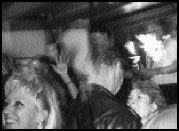Not so long ago, you could drive down just about any state highway in America and run into a few good examples of so-called “roadside vernacular” architecture. For a brief period back in the 1950s and ’60s, buildings like the Twin Tepees, demolished last July, were everywhere. Enormous ice cream cones; coffee kiosks shaped like coffee mugs; and giant, drive-through doughnuts functioned as their own road signs—big enough to be visible at 55 mph, weird enough to draw a healthy share of travelers off the highway.
Roadside attractions slowly disappeared from the urban landscape after the mid-20th century. The last remaining examples in Seattle—the weirdly iconic Hat n’ Boots, which rise out of a government-owned field in Georgetown—are badly in need of repair. The giant hat and cowboy boots—constructed in 1954 out of plaster, steel beams, and chicken wire— once served as the office and rest rooms (one boot for the women, one for the men) for the most heavily trafficked gas station in the state. Even Elvis peed there. But after I-5 was completed, according to Historic Seattle preservation advocate Heather MacIntosh, the 99 corridor fell out of favor with drivers, and a planned shopping complex never materialized. Even so, the Hat n’ Boots hung on until 1988, when their doors were shut for good.
For nearly 15 years, the Hat n’ Boots have gradually succumbed to the elements, losing their windows and most of their paint. But last month, the buildings got a new lease on life, when the city’s Landmarks Board granted historic status to the aging structures. The designation means the buildings will be preserved and restored to their original appearance, with the help of donations and state and federal grants totaling $200,000. The Georgetown Community Council, which owns the Hat n’ Boots, plans to move them to the new Oxbow Park, where they’ll serve as an interpretative center and a storage shed for the neighborhood P-Patch. “This is Georgetown’s landmark,” says the community council’s LaDele Sines. “It’s really important for the community to keep them in our neighborhood and preserve them in some way.” . . .
Supporters of Referendum 51 (R-51), the statewide gas-tax measure, would have you believe their proposal will remedy more than 2,000 “high-accident” locations and 950 damaged bridges throughout the state. In its campaign literature, Yes on 51 characterizes the gas tax as, first and foremost, a “safety” plan. It even drags the children, who must be exhausted from campaigning for the latte tax (also on the ballot in November), into the fray, claiming that R-51 will fix dangerous school crosswalks and “improve street safety near schools.” But if the children are indeed endangered by Washington’s lousy street system, R-51 won’t do much to help them. In fact, according to the Washington Department of Transportation, only $33 million of the statewide gas tax would be spent on safety improvement projects—less than one-half of 1 percent of the $7.7 billion total. The rest would partially fund a long list of megaprojects—like widening I-405 from Lynnwood to Tukwila, estimated to cost anywhere from $9 billion to $11 billion—and lesser-known endeavors, like extending SR 504 through the middle of Mount St. Helens and widening several freeways outside the urban growth boundary. . . .
Neither R-51 nor the monorail managed to win the support of the liberal 43rd District Democrats, who voted last week not to endorse either measure. The gas-tax measure lost on a hair-thin margin of two votes, thanks largely to endorsements by state legislator Ed Murray and House speaker Frank Chopp. “They liked the fact that the principle revenue in R-51 comes from a gas tax,” rather than an across-the-board levy, district chair Richard Kelley says. The monorail, which would be funded by an annual motor vehicle tax, failed to win the required two-thirds vote by a margin of 8 percent. It couldn’t have helped that the monorail line won’t come anywhere close to the 43rd, which stretches from the University District to Belltown. Although the district has rarely met a tax it doesn’t like, “You’re really asking people here to do a pretty altruistic thing—to pay hundreds of dollars” in new car taxes, Kelley says.








